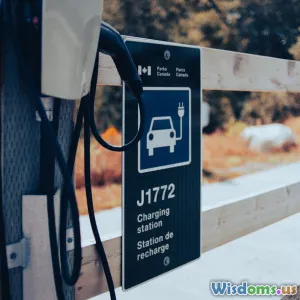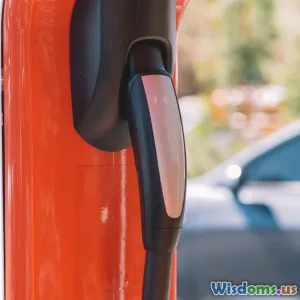
How to Extend the Lifespan of Your Hybrid Vehicle Battery
8 min read Master practical tips and expert insights to prolong your hybrid vehicle's battery life effectively. (0 Reviews)
How to Extend the Lifespan of Your Hybrid Vehicle Battery
Hybrid vehicles offer an eco-friendly balance of fuel efficiency and electric power, but their advantages hinge heavily on the health of their battery systems. The hybrid battery is arguably the most critical — and expensive — component in these cars. Understanding how to extend the lifespan of your hybrid vehicle battery can save you thousands, increase your vehicle's resale value, and reduce environmental impact.
In this article, we'll break down actionable strategies and best practices rooted in science and real-world experiences to help you get the most mileage and years out of your hybrid battery.
Why Battery Lifespan Matters
Hybrid batteries typically come with warranties ranging from 8 to 10 years or 100,000 to 150,000 miles, reflecting both their durability and the manufacturer's confidence. However, many owners wonder how they can stretch that lifespan further. Given that replacement costs can range from $3,000 to $8,000 depending on the make and battery type, maximizing longevity is a practical priority.
Moreover, environmental goodwill can be enhanced by prolonging the battery life since battery production and disposal have notable ecological footprints.
Understanding Hybrid Vehicle Batteries
Modern hybrids primarily use lithium-ion or nickel-metal hydride (NiMH) batteries. Each has distinct care requirements; however, many principles to extend battery life overlap:
- Lithium-Ion (Li-ion): Lighter with higher energy density, but more sensitive to temperature extremes.
- Nickel-Metal Hydride (NiMH): More tolerant but heavier and can suffer from 'memory effect' if consistently charged improperly.
Knowing your battery type is the first step in tailoring maintenance approaches.
Effective Tips to Prolong Your Hybrid Battery
1. Maintain Optimal Temperature Conditions
Heat is one of the most potent battery killers. Batteries operate best within a moderate temperature range (around 20°C to 25°C or 68°F to 77°F). Exposing your hybrid vehicle to extreme heat can accelerate degradation.
Actionable tips:
- Park in shaded areas or garages during hot weather.
- Use sunshades to reduce cabin temperature exposure.
- During cold weather, allow the vehicle to warm up gently rather than heavy acceleration immediately.
A 2019 study by the Idaho National Laboratory revealed that hybrid batteries exposed consistently to high temperatures (>35°C or 95°F) could see up to a 20% reduction in capacity over five years compared to those maintained in cooler climates.
2. Avoid Deep Discharges and Overcharging
Just like any rechargeable battery, excessive cycling between full charge and complete discharge can shorten its effective life.
Modern hybrids are designed to mitigate this risk by managing charge levels automatically; however, owner behavior still plays a role. For example, keeping your vehicle turned off for extended periods can sometimes cause deeper discharges in some models.
Recommendations:
- Drive your vehicle regularly, aiming for consistent trips rather than infrequent long intervals.
- Avoid leaving the hybrid powered off for weeks at a time.
3. Manage Driving Habits
Gentle acceleration and braking reduce strain on the battery. Utilizing regenerative braking maximally helps recharge the battery effectively.
A report from the U.S. Department of Energy highlights that hybrids driven predominantly in stop-and-go city traffic can maintain batteries better than those mostly on high-speed highways, largely due to frequent regenerative braking.
4. Scheduled Maintenance and Expert Diagnostics
Routine checks from certified hybrid mechanics can identify early warning signs of battery degradation. Some high-tech diagnostic tools measure individual cell voltage and temperature to spot weak links.
Ignoring warning lights or symptoms like drastic drops in fuel economy or erratic electric motor assistance can result in irreversible damage.
5. Software Updates and Battery Management Systems (BMS)
Manufacturers periodically release software updates optimizing battery management systems. These updates balance charge cycles better, improve cooling strategies, and can even recalibrate battery sensors.
Ensure your dealership or trusted service center installs these updates, which can add years to battery life.
6. Limit Exposure to Extreme Cold
While heat is more harmful, extremely low temperatures can temporarily reduce battery performance and, if frequently exposed, contribute to degradation.
Warm up your hybrid appropriately in colder months but avoid excessive idling, which wastes fuel.
7. Charging Considerations
Unlike pure electric vehicles, hybrids primarily charge their batteries via regenerative braking and the gasoline engine. Plug-in hybrids, however, rely partly on external charging.
For plug-in hybrids:
- Avoid keeping the battery at 100% charge for extended periods.
- Use scheduled charging features when available to charge during cooler evening hours.
Real-Life Examples
-
Toyota Prius: Recognized as one of the most reliable hybrids, Priuses often see batteries easily last 10+ years with minimal degradation following consistent maintenance and mindful driving.
-
Ford Fusion Hybrid: Owners reporting significant battery issues usually reflect neglect of scheduled maintenance or exposure to extreme climates without mitigating steps.
Such contrasting experiences underscore the practical impact of following manufacturer guidelines and battery care strategies.
Conclusion
Extending your hybrid vehicle battery's lifespan is less about expensive fixes and more about consistent, informed care. From parking in shade to adopting fuel-friendly driving habits, your everyday choices profoundly impact battery longevity.
Remember, while technology handles many protections automatically, your proactive approach complements and enhances these systems’ effectiveness. Doing so not only saves you money but reduces environmental strain, making your hybrid ownership experience more satisfying in the long term.
By implementing the tips and strategies outlined here, you're well-equipped to get the best performance and longest life from your hybrid battery — and keep your eco-friendly journey on the road for years to come.
Sources:
- Idaho National Laboratory Studies on Battery Aging
- U.S. Department of Energy - Hybrid Electric Vehicle Technologies
- Manufacturer Owner Manuals and Service Guidance (Toyota, Ford)
Engage your hybrid battery care proactively, and share your experiences to empower fellow drivers!
Rate the Post
User Reviews
Popular Posts


















